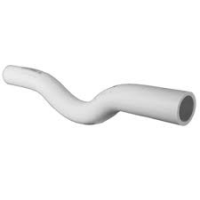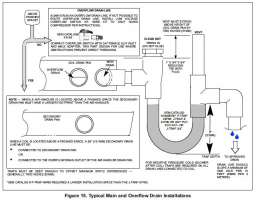Recently had a new hvac system installed in one of my buildings. 5 T split system, they retained the ductwork, replaced the condensor and fan coil units. Question is about the condensate drain line ... they used what I call a u-trap ... the bent pvc pipe that looks like it sagged from heat. A very shallow U. Is that code compliant?
-
Welcome to The Building Code Forum
Your premier resource for building code knowledge.
This forum remains free to the public thanks to the generous support of our Sawhorse Members and Corporate Sponsors. Their contributions help keep this community thriving and accessible.
Want enhanced access to expert discussions and exclusive features? Learn more about the benefits here.
Ready to upgrade? Log in and upgrade now.
You are using an out of date browser. It may not display this or other websites correctly.
You should upgrade or use an alternative browser.
You should upgrade or use an alternative browser.
HVAC condensate line
- Thread starter e hilton
- Start date
north star
MODERATOR
- Joined
- Oct 19, 2009
- Messages
- 4,596
Provide pictures.I have other problems with the installation that indicate the installers were not shy about cutting corners.
Paul Sweet
SAWHORSE
This looks typical, but inadequate. The trap should be 2" deep; the one North Star showed might be half that, at best. It probably needs a relief vent on the discharge side to keep the water from being sucked back through the trap if the coil is draw-thru.
They might be able to get away with this if the condensate spills out on grade or discharges into a sink or indirect drain. It's dangerous if it discharges into a sewer line, because sewer gasses will get into the air stream.
They might be able to get away with this if the condensate spills out on grade or discharges into a sink or indirect drain. It's dangerous if it discharges into a sewer line, because sewer gasses will get into the air stream.
Attachments
klarenbeek
REGISTERED
That trap should be adequate for most typical residential style systems, especially if the AC coil is upstream of the blower. If done to code, the sewer gas issue shouldn't come into play because condensate drain lines are supposed to be an indirect connection with an air gap, like at a floor drain or a laundry standpipe. They can't be connected directly to the sewer drain line.
Ok, a bit of follow-up. The contractor is required to submit copies of O&M manuals as part of the project. I looked at the Trane installation instructions for the fan coil unit, it has a very clear diagram similar to the one paul posted, with somple calcs to determine the depth of the trap. Apparently there is negative pressure on the equipment side of the trap, so the instructions say “dimension should at least equal two times the maximum negative static pressure that can occur in the system”.
We have a bit of a convoluted system, i have to get the blessing of the local maintenance manager before closing the project. If they find fault with any part of my project they won’t sign off and accept it. So i turned the tables: told him what i see wrong with the installation and gave a copy of the diagram, and said if he’s ok with it he needs to sign the turnover form.
The installer sent a dozen pictures, and in one of them i found a j-box with an open knockout. I pointed that out and told the maintenance guy it needs to be plugged. He said it’s not this installer responsibility, it was an existing condition. I said too bad, he touched it, he has to make it right. I inherited this project from another PM who suddenly left one friday, and I don’t think i am making friends with the local FM’s.
We have a bit of a convoluted system, i have to get the blessing of the local maintenance manager before closing the project. If they find fault with any part of my project they won’t sign off and accept it. So i turned the tables: told him what i see wrong with the installation and gave a copy of the diagram, and said if he’s ok with it he needs to sign the turnover form.
The installer sent a dozen pictures, and in one of them i found a j-box with an open knockout. I pointed that out and told the maintenance guy it needs to be plugged. He said it’s not this installer responsibility, it was an existing condition. I said too bad, he touched it, he has to make it right. I inherited this project from another PM who suddenly left one friday, and I don’t think i am making friends with the local FM’s.
Not even close. First of all, it has to be dead flat and even at that there isn't enough trough. Here's a few that do work.# ? # ? # ?
e hilton,
Yes, that "shallow" looking U - trap is a compliant
form of a P-trap.
Section 307.2.4 from the `18 IMC requires all condensate
drain lines to be trapped.
View attachment 7072
+ ( ) + ( ) +

Attachments
Last edited:
ADAguy
REGISTERED
Good discussion
Paul Sweet
SAWHORSE
IMC 307 just requires condensate to go to an "approved place of disposal." Many sewer authorities don't want to have to deal with more water than necessary, so I generally discharge it to the storm drainage system, or directly to the ground if it is a small system. There may be a few AHJs that only approve the sanitary sewer.
ADAguy
REGISTERED
Be wary of standing water attracting skeeters.Are the RTU's (Roof Top Units) allowed to drain on the roof to the roof drain system or gutter?
mtlogcabin
SAWHORSE
We allow it here but we require them to run the line 10 ft away from the unit due to the ice that will form and will cause an unsafe working surface for the service techs.Are the RTU's (Roof Top Units) allowed to drain on the roof to the roof drain system or gutter?


